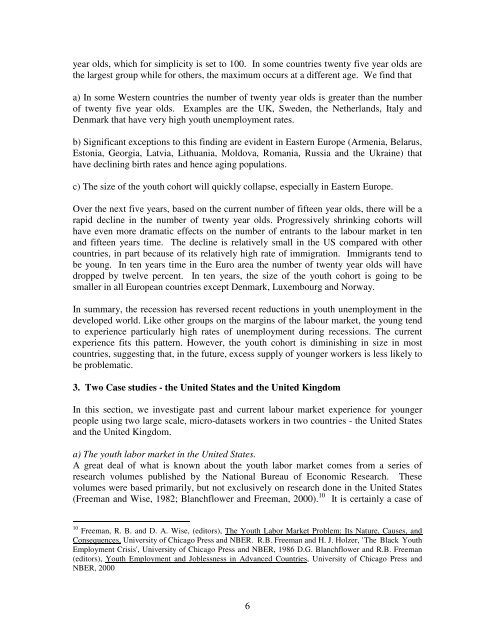Youth Unemployment: Déjà Vu? - Index of - IZA
Youth Unemployment: Déjà Vu? - Index of - IZA
Youth Unemployment: Déjà Vu? - Index of - IZA
Create successful ePaper yourself
Turn your PDF publications into a flip-book with our unique Google optimized e-Paper software.
year olds, which for simplicity is set to 100. In some countries twenty five year olds are<br />
the largest group while for others, the maximum occurs at a different age. We find that<br />
a) In some Western countries the number <strong>of</strong> twenty year olds is greater than the number<br />
<strong>of</strong> twenty five year olds. Examples are the UK, Sweden, the Netherlands, Italy and<br />
Denmark that have very high youth unemployment rates.<br />
b) Significant exceptions to this finding are evident in Eastern Europe (Armenia, Belarus,<br />
Estonia, Georgia, Latvia, Lithuania, Moldova, Romania, Russia and the Ukraine) that<br />
have declining birth rates and hence aging populations.<br />
c) The size <strong>of</strong> the youth cohort will quickly collapse, especially in Eastern Europe.<br />
Over the next five years, based on the current number <strong>of</strong> fifteen year olds, there will be a<br />
rapid decline in the number <strong>of</strong> twenty year olds. Progressively shrinking cohorts will<br />
have even more dramatic effects on the number <strong>of</strong> entrants to the labour market in ten<br />
and fifteen years time. The decline is relatively small in the US compared with other<br />
countries, in part because <strong>of</strong> its relatively high rate <strong>of</strong> immigration. Immigrants tend to<br />
be young. In ten years time in the Euro area the number <strong>of</strong> twenty year olds will have<br />
dropped by twelve percent. In ten years, the size <strong>of</strong> the youth cohort is going to be<br />
smaller in all European countries except Denmark, Luxembourg and Norway.<br />
In summary, the recession has reversed recent reductions in youth unemployment in the<br />
developed world. Like other groups on the margins <strong>of</strong> the labour market, the young tend<br />
to experience particularly high rates <strong>of</strong> unemployment during recessions. The current<br />
experience fits this pattern. However, the youth cohort is diminishing in size in most<br />
countries, suggesting that, in the future, excess supply <strong>of</strong> younger workers is less likely to<br />
be problematic.<br />
3. Two Case studies - the United States and the United Kingdom<br />
In this section, we investigate past and current labour market experience for younger<br />
people using two large scale, micro-datasets workers in two countries - the United States<br />
and the United Kingdom.<br />
a) The youth labor market in the United States.<br />
A great deal <strong>of</strong> what is known about the youth labor market comes from a series <strong>of</strong><br />
research volumes published by the National Bureau <strong>of</strong> Economic Research. These<br />
volumes were based primarily, but not exclusively on research done in the United States<br />
(Freeman and Wise, 1982; Blanchflower and Freeman, 2000). 10 It is certainly a case <strong>of</strong><br />
10 Freeman, R. B. and D. A. Wise, (editors), The <strong>Youth</strong> Labor Market Problem: Its Nature, Causes, and<br />
Consequences, University <strong>of</strong> Chicago Press and NBER. R.B. Freeman and H. J. Holzer, ' The Black <strong>Youth</strong><br />
Employment Crisis', University <strong>of</strong> Chicago Press and NBER, 1986 D.G. Blanchflower and R.B. Freeman<br />
(editors), <strong>Youth</strong> Employment and Joblessness in Advanced Countries, University <strong>of</strong> Chicago Press and<br />
NBER, 2000<br />
6
















